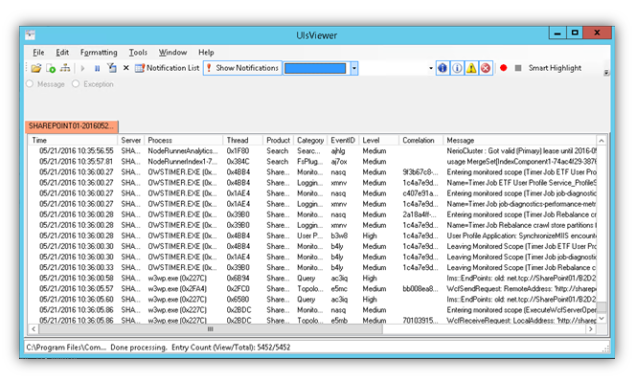In this post I’m going to show you how to find the details of an error in the SharePoint log files.
Scenario
Sorry, something went wrong. An unexpected error has occurred.
Many of us have seen this non-informative message before, wondering what really happened.

We need a way to get the real SharePoint exception to investigate the problem.
Solution
We can do that by using the SharePoint “Unified Logging System” (ULS).
SharePoint saves the details of errors and other diagnostic information in a log file on the server where the error happened.
Steps
1. Get Correlation ID
The first step is to note the Correlation ID.
You can directly copy it from the browser in the SharePoint error page.

2. Get and Open ULS Viewer
You can open log files with Notepad or your text editor of choice.
However Microsoft has a tool called ULSViewer that can help you find your error more easily with the use of filters.

3. Open Log File
Now you need to find and open the specific log file that contains your error.
To open a log file click on File -> Open From -> File.

By default SharePoint log files are stored in the SharePoint hive in the LOGS folder:
C:\Program Files\Common Files\microsoft shared\Web Server Extensions\15\LOGS
 However note that this path can be changed in SharePoint Central Administration.
However note that this path can be changed in SharePoint Central Administration.
SharePoint log files are named with the format “SERVERNAME-YYYYMMDD-HHMM.txt” where SERVERNAME is the server’s computer name, YYYYMMDD is the current date and HHMM is the time the log was started using a 24-hour clock.
In single server farms open the log from the day and time which the error happened.
In multi-server farms you’ll need to go to the specific server where the error happened to locate the log. If it’s not immediately obvious where the error happened you’ll need to check every server in the farm.

4. Filter Log Entries
To find your error you will need to filter the log entries by Correlation ID and Level.
To do this click on Edit -> Modify Filter.

Then set the following values in the Filter By dialog.
Correlation ID filter:
Field: Correlation
Operation: Equals
Value: The Correlation ID you copied from the SharePoint Error message
And/Or: And
Level filter:
Field: Level
Operation: Equals
Value: Unexpected

Click OK and ULSViewer will show only the events that have the Correlation ID and Level specified.

Conclusion
Now we can finally see the real error!
If you double click on the log entry, a window will open to show all the error details so that you can begin your investigation.




